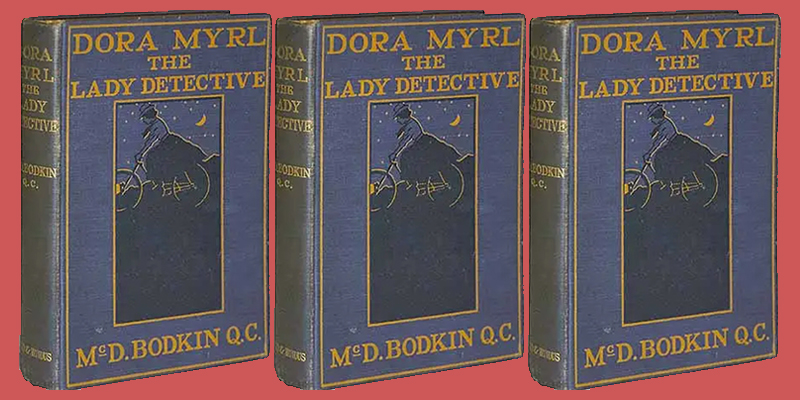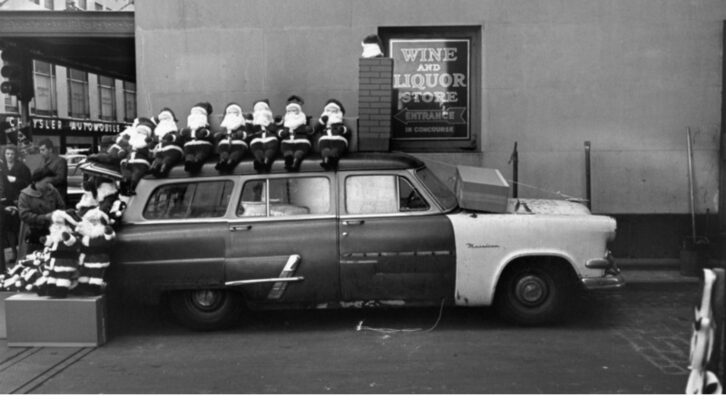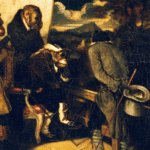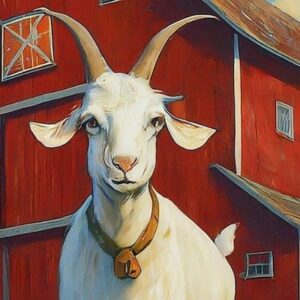Dora Myrl is the protagonist of twelve stories by M. M. Bodkin (a male author) that were serialized in Pearson’s Weekly from May through August 1899, before being published in a single volume called Dora Myrl, Lady Detective, in 1900. An energetic polymath, Dora is the daughter of a Cambridge don whom, she believes, had wished she were a boy. She studied mathematics at Cambridge, where she was Head Girl and became a Wrangler (a title given to those who receive first-class honors in that specialization in their final year). She “had no taste for the humdrum life of schoolteaching,” so she continued her education, earning a medical degree. But after she graduates, she cannot find work as a physician, and so winds up trying out odd-jobs—“a telegraph girl, a telephone girl, lady journalist.” By the time she begins (amateur) detective work, she is the paid companion of a wealthy woman.
I want to pause, briefly, to underscore Dora’s accomplishments. She’s brilliant: a Cambridge-educated mathematics student who achieved first-class honors-TURNED-physician. She can’t find work, because she is a woman looking for careers in male fields, so she has to take lower-paying, low-level jobs. This is a tragedy, IMO, but there are sadder fates awaiting Dora. Lay on…
Readers of my work on Victorian detective fiction will note that I’m particularly interested in overlaps between themes of performance and crime-solving in literature and entertainment of this time-period, so I will state that I find it noteworthy that Dora does not become an actress during this exploratory period (because it seems that she has tried almost every possible job available to her except that). She does, though, keep company with actresses (especially her close friend, the famous actress Nina Lovell), and is implied to as being a member of “literary and artistic London.” She is moved by plays and music and possesses a dramatic flair, donning accents to jest with her friends. And in her detective work, she has a tremendous commitment to disguise and performance—frequently employing those methods to track down and surveil various parties.
Given her proximity to the theatre and her prodigious performance abilities, the question becomes, why isn’t Dora given a history on the stage? Presumably, Bodkin does not make Dora an actress because it seems too distant a profession from the hyper-intellectual, extra “masculine” skill sets she has cultivated. With her traditionally male upbringing and accomplishments, she exists deeper in the realm of the masculine than traditional male detectives.
The stories seem determined to code her as being fascinatingly, anomalously rational, as dissimilar to the presumed emotional orthodoxies of womankind—and the bodily and emotional baseline of the stage actress—as possible. Her observational and clue-finding abilities are compared to “a skilled physician searching a patient’s body with a stethoscope when he finds the lurking disease at last.” She is also given practical know-how that crosses the line into the masculine; in the story “How He Cut His Stick,” she a man at gunpoint after chasing down his train on her bicycle, calmly pointing a revolver “straight at his head.”
This commitment to her masculine qualities is exaggerated by Dora’s performance choices. She is a good actress, but this tracks back less to a presumed-womanly penchant for emotional performance and more towards the attempts to associate her with excellence, in a masculine sense. Dora usually disguises herself as men (from telegraph boys to French male detectives), and does so convincingly, despite not having any stage training (not even amateur performance at Cambridge). The male detective disguise is a bolder and more transgressive disguise preference than any other heroine in this canon wears—and it suggests that being a female detective is not a strong enough credential to allow her access to certain places or perspectives, or to intimidate people in the necessary way. (The making of the detective “French” is almost certainly an attempt to offer a stereotypical explanation for and counteract any perceived femininity or preciousness she may inadvertently transmit.)
Even the descriptions of her disguises, especially her “cute little chap” of a male French detective, Monsieur Duval, determine a tone of playfulness and curiosity about, a lighthearted experimentation with gender expectations and potential. It is possible to employ the framework that Elizabeth Carolyn Miller uses to describe the Victorian lady detective character of Loveday Brooke from 1893—the “She-Dick,” a lady detective who subverts the era’s gender norms. Like Loveday, these stories also clearly establish Dora as a New Woman (not only because of her commitments to education and career, but also through her hobby of bicycle riding). The Dora Myrl stories certainly are not so forward-thinking or proto-feminist as to suggest that Dora’s enduring “feminine” qualities are the result of social performance, or that gender as a concept whole relies on the strict maintenance and promotion of a set code of behaviors and appearances. But there is a clear way the stories demand that ratiocination is the purview of the female brain, as well. When a villain named Dr. Phillimore challenges her, asking if she thinks women are adequate matches for “cunning and strong men,” Dora responds, “Women are clever and men are confident; their confidence betrays them.” It is men, and not women, who are unable to reach their ratiocinative potential because their bodies thought to be governed by emotions.
Phillimore tries to toy with her, asking her how she would manage to arrest him, if he were the criminal at hand. “I could crush the life out of you with my naked hand,” he says, and flexes his arm to prove it: “Smilingly, he stretched out a large shapely white hand, and the muscles packed like a cable coil on his arm stirred under the tightened sleeve of his evening coat.” As J. A. Kester has pointed out, the Dora Myrl stories feature as their villains male sociopaths and sexual predators. Phillimore is one of four predatory men with a track record of assaulting women with whom Dora must do battle. Thus, a major theme of the Dora Myrl mysteries is—rather than debunking the presumed emotional or bodily essence of women—to reveal the ways men are ruled by their physicality and emotion.
With Dora, who is able to accomplish everything a man can without her emotional state undermining her makes rationality and cleverness more the purview of the feminine essence than a masculine one. Given the Dora Myrl stories’ insistence on these themes, it is especially noteworthy that she is prevented from (formally) having worked on the stage—reinforcing that the emotional nature of the actress is something that she would have to overcome, in order to become a bona—fide detective.
So what happens to Dora?
The Dora Myrl stories do, as almost all lady detective stories do, returning to the domestic sphere and firmly planting her in the world of the “feminine.” In a sequel to this collection, Dora stops using her masculine disguises (and working as a detective altogether) when she marries an older male detective named Paul Beck (another one of Bodkin’s detective characters from a hitherto-standalone series). She becomes a wife and mother, and is content with domestic labor for the rest of her life. An ensuing book chronicles how their son grows up to be a detective, as well.

















